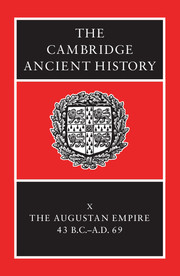13a - Italy and Rome from Sulla to Augustus
from 13 - The West
Published online by Cambridge University Press: 28 March 2008
Summary
EXTENT OF ROMANIZATION
The enfranchisement of peninsular Italy in and immediately after 90 B.C., and of Transpadane Gaul in 49 B.C., was the culmination of a process which had begun in the fifth century B.C. Similarly, the Romanization of Italy and the ‘Italianization’ of Rome, although both proceeded at an accelerated pace in the generations which followed the Social War, were phenomena whose roots lay deep in the past. In offering an interpretation of the essential features of the changing relationship between Rome and Italy from Sulla to Augustus, one must perforce take for granted much of their earlier history.
A few words, however, by way of introduction. Within both the insurgent and the loyalist areas in 91 B.C., there were substantial variations in the extent of Romanization. Thus, of the Samnites and the Marsi, who both rebelled, the former still spoke their own language and used their own alphabet, the latter wrote and spoke Latin. The linguistic diversity of rebel Italy is indeed perfectly reflected in its bilingual coinage. The Samnites moreover remained directly acquainted with Greek cultural models down to the outbreak of war, for the Marsi these had probably long been mediated through Rome. Similarly, of the Etruscans, whose part in the rebellion lay somewhere on a scale between the minimal and the non-existent, the southern peoples had largely ceased to speak Etruscan or to function as autonomous centres of artistic production in the third century B.C., the northern cities remained Etruscan in their language and in their art.
- Type
- Chapter
- Information
- The Cambridge Ancient History , pp. 414 - 433Publisher: Cambridge University PressPrint publication year: 1996
References
- 12
- Cited by



